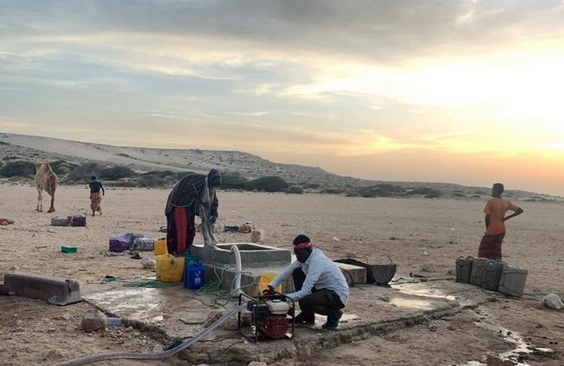
Pre-drought conditions worsen in many parts of Somalia

MOGADISHU (SOMALIA) - In March, large parts of the country faced severe drought conditions, triggered by below average 2020 Deyr rains and above average temperatures during the Jilal season. Over 116,000 Somalis were displaced by water shortages between October 2020 and March 2021.
In Lower Shabelle region of South West State, authorities and partners have reported that a 200-litre barrel of water currently costs around $4.5, a 20% increase compared to prices in December 2020.
In Middle Shabelle, consequences of water shortages forced about 5,000 farmers among riverine communities in Jowhar and Mahadaay to flee to Mogadishu in search of casual labour to support their families.
According to the FAO latest drought update, the worst affected regions include Lower Juba, Middle Juba, Gedo, Mudug, Nuugal, Bari, Toghdheer and Sool which are currently experiencing severe water shortages for domestic, livestock and agricultural production purposes.
Availability of water and pasture conditions have significantly deteriorated, leading to increased livestock migration and rapid rise of water prices. In Puntland, the price of water in most rural villages has doubled since the beginning of March as the dry conditions persist in most rural villages and settlements across the state. By the end of March, a 200-litre barrel of water sold between USD$7 to $9, up from an average of $3 in February 2021.
In a Drought Need Assessment conducted in February by an NGO in Sool, Sanaag and Togdheer regions, about one-third of communities do not have access to sufficient water, with 88 per cent of water points unable to produce sufficient water for drinking. In Jubaland, 200-liter barrel cost about USD $14 as water pans which were the main source of water in the area dried up. As a result of the ongoing situation, water is trucked from locations 60 kilometers away for communities in Burgabo village in Jubaland.
In Lower Shabelle region of South West State, authorities and partners have reported that a 200-litre barrel of water currently costs around $4.5, a 20% increase compared to prices in December 2020.
In Middle Shabelle, consequences of water shortages forced about 5,000 farmers among riverine communities in Jowhar and Mahadaay to flee to Mogadishu in search of casual labour to support their families.
According to the latest UNICEF humanitarian situation report the water shortages and challenges of getting safe drinking water has contributed to cases of acute watery diarrhea (AWD) /cholera cases in some areas across the country.
According to Federal Ministry of Health and Human Services, a total of 88 suspected cases of cholera were reported in the last week of February from Bay, Afgoye, Merka and Banadir regions, with no reported deaths. As of 23 March, the cumulative total number of suspected cholera cases in 2021 was 780, including 2 associated deaths with a case fatality ratio (CFR) of 0.3%.
In response to the water crises, both federal and local authorities, and humanitarian partners are providing support in various areas. The humanitarian leadership mobilized $13.3 million from the Somalia Humanitarian Fund and $7 million from the Central Emergency Response Fund (CERF) to facilitate rapid response efforts for populations hardest hit by the water-shortage crisis as well as up to $20 million to activate the Anticipatory Action Framework. Puntland authorities have secured funding to rehabilitate five strategic boreholes with replacement of submersible pump, control panel, pipes, motors and storage tanks.
Once repaired, all five boreholes will serve up to 15,000 people cumulatively thus reducing the pressure on available water access points. In Hiraan region, UNICEF has responded to areas affected by water shortages with water trucking in Belet Weyne, reaching about 18,000 people.
Disease surveillance is being managed with the support from WHO through the the Early Warning Alert and Response Network (EWARN) and is currently being expanded to all health facilities across the country.
Source: OCHA
Leave a comment
- Popular
- Rated
- Commented
04/11/2021 - 11:05:02
12/03/2023 - 22:58:08
22/01/2023 - 11:24:06
13/12/2015 - 09:27:08
01/03/2021 - 09:00:37
Opinions
17/05/2024 - 23:10:22
14/05/2024 - 21:03:09
30/04/2024 - 01:33:18
Politics
06/05/2024 - 02:52:53
02/05/2024 - 23:52:49
Terror Watch
12/05/2024 - 00:19:20
07/05/2024 - 15:08:55
Press Releases
18/05/2024 - 10:24:36
 0
0 



































Pre-drought conditions worsen in many parts of Somalia
MOGADISHU (SOMALIA) - In March, large parts of the country faced severe drought conditions, triggered by below average 2020 Deyr rains and above average temperatures during the Jilal season. Over 116,000 Somalis were displaced by water shortages betw